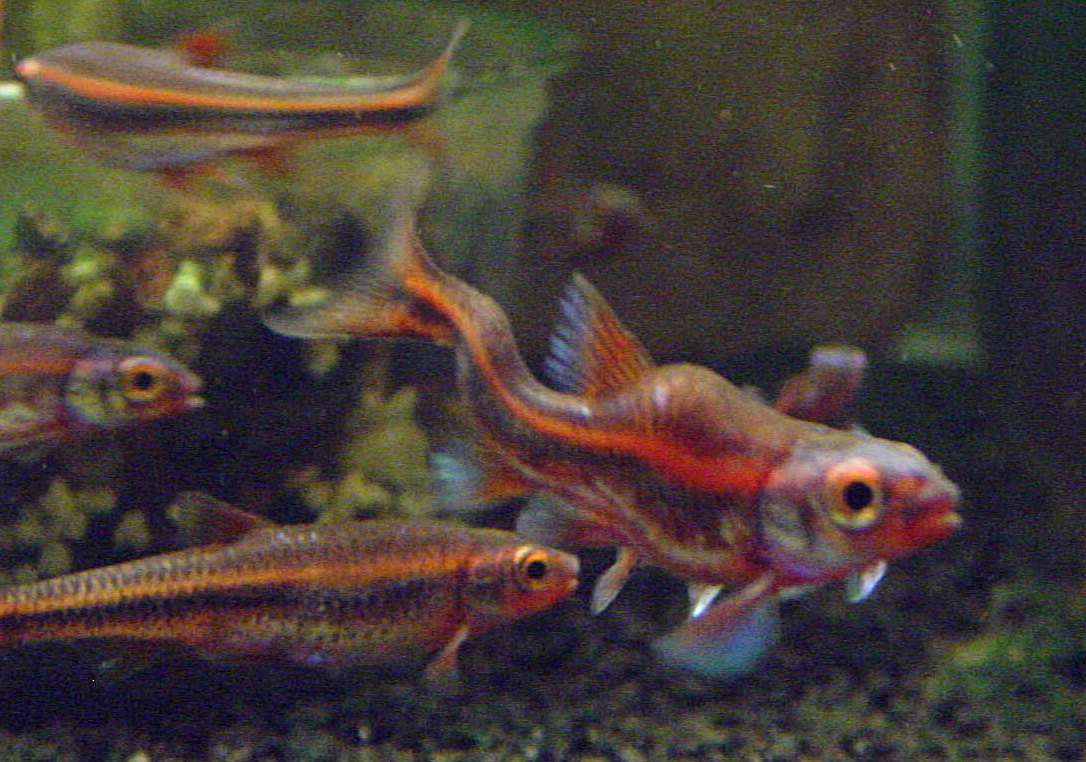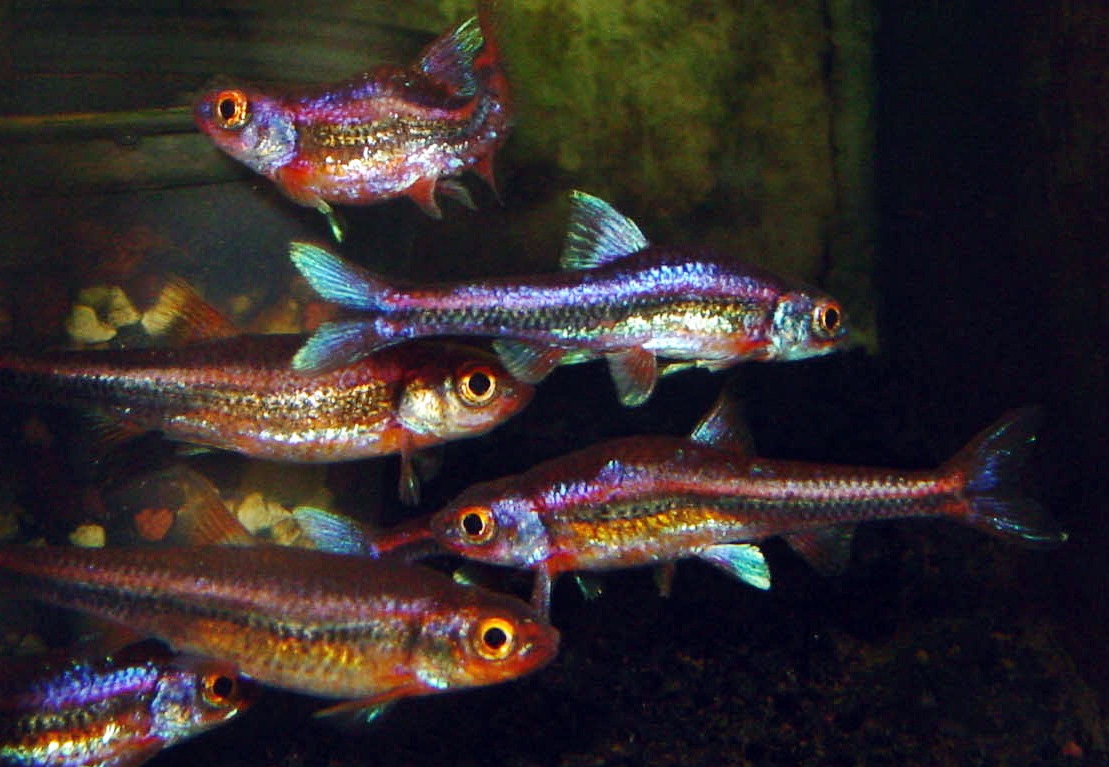Scoliosis in Fishes
#1
 Guest_PoKay_*
Guest_PoKay_*
Posted 31 December 2010 - 02:23 PM
We are writing to solicit donations of specimens or sharing of documented incidence. We would appreciate greatly receiving specimens of abnormal fishes from anyone who has them and is willing to part with them. If actual specimens are not available, photographs are also greatly appreciated.
Any questions regarding this request or our project may be directed to PoKay Ma at <pokay@qc.edu> or at Department of Biology, Queens College, The City University of New York, Flushing, New York, 11367, U.S.A.
Many thanks.
#3
 Guest_PoKay_*
Guest_PoKay_*
Posted 01 January 2011 - 05:39 PM
How do you tell the difference between a fish that has genuine scoliosis and a fish infected with mycobacterium marinum? In both cases the spines would curve, right?
Yes, the spines would curve in both cases. We cannot determine the causes of vertebral abnormalities at this point. Many studies have shown that the causes may include genetics, parasites, pollutants and other environmental factors, or a number of other factors. We would like to determine whether there are consistencies in some parameters of scoliosis: the position of the kinks, the magnitude of the curvature, the pathology of the vertebrae and other skeletal elements involved, etc. Some of these parameters may be correlated with the causes.
Since scoliosis is not uncommon among fishes, we would like to compare abnormalities among species. For example, we would like to know whether there are differences between deep-bodied fishes and long-bodied fishes, or whether the nature of scoliosis correlates with the number of body segments. Consistent differences or correlations may implicate a role of biomechanical constraints on the abnormalities.
#4
 Guest_EricaWieser_*
Guest_EricaWieser_*
Posted 01 January 2011 - 10:21 PM
Edit:
Also, my tank is positive for mycobacterium marinum. Every now and then when a fish is old aged and stressed, it will succumb to the omnipresent pathogen, its spine curves, and it slowly wastes away. I don't have any fish at the moment who have curved spines, but I did have one just two months ago. I would have sent it to you. *shrugs* oh well
Edited by EricaWieser, 01 January 2011 - 10:23 PM.
#5

Posted 04 January 2011 - 11:58 AM
PM me for more information if interested.
#7
 Guest_PoKay_*
Guest_PoKay_*
Posted 06 January 2011 - 08:40 PM
Wow, I imagine that that would involve analyzing a lot of data. Is this your doctoral thesis project?
Edit:
Also, my tank is positive for mycobacterium marinum. Every now and then when a fish is old aged and stressed, it will succumb to the omnipresent pathogen, its spine curves, and it slowly wastes away. I don't have any fish at the moment who have curved spines, but I did have one just two months ago. I would have sent it to you. *shrugs* oh well
No, this is not thesis work. Perhaps you can say that this is just a hobby.
What kind of fish do you have? It is not clear whether all fishes are susceptible to Mycobacterium, at least not the same species of bacteria. I do not know this for sure. If you have fish in the future, we would love to have them, or at least pictures of them.
#8
 Guest_PoKay_*
Guest_PoKay_*
Posted 06 January 2011 - 08:54 PM
I have an adult Yellow perch exhibiting a good case of both scoliosis and lordosis. This is an exceptionally old aniamal with no previously known ailments/diseases. The spinal issues were noticed just under 2 years ago.
PM me for more information if interested.
This is really interesting. There is little information on how long fish with scoliosis can survive. They certainly do not do well in the wild. Two years is a long time Ė longer then the lifespan of a lot of fishes.
I have several questions. (a) Is the severity of curvature progressive over the past two years? (b) If the curvature has changed over time, where (on the body axis) did it start when first noticed, and where are the additional curvatures that developed with time? © I presume that you have this fish in a tank. Do you have any idea how old it is? (d) Is there any chance we can have a picture of this fish? A profile and a birdís eye image would be lovely.
Many thanks.
#9
 Guest_PoKay_*
Guest_PoKay_*
Posted 06 January 2011 - 08:56 PM
Both. At this point, we are hoping to compile records of any fish anywhere. The more information and the more thorough the information the better.Just for clarification - Are you looking for information on wild specimens, or those in captivity? Or both?
#10
 Guest_EricaWieser_*
Guest_EricaWieser_*
Posted 06 January 2011 - 09:15 PM
Xiphophorus montezumae are highly susceptible to Mycobacterium, for sure. I once lost an entire colony of 14 of them to it. Xiphophorus hellerii may also contract Mycobacterium, but the hellerii and maculatus living in the same tank with the montezumae survived while every single one of the montezumae eventually died. I spoke to a montezumae breeder in southeast asia who had the same problem with his montezumae, and we concluded that both of our waters were too warm for wild caught or F1 montezumae but fine for the domesticated strains of hellerii and maculatus. A stressed out fish seems infinitely more susceptible to showing symptoms of Mycobacterium marinum than a healthy fish.What kind of fish do you have? It is not clear whether all fishes are susceptible to Mycobacterium, at least not the same species of bacteria. I do not know this for sure. If you have fish in the future, we would love to have them, or at least pictures of them.
My Elassoma gilberti have not yet shown any signs of Mycobacterium.
I do have two videos that show diseased fish. I tried to avoid catching the sick fish in the film, but you can't miss them if you know what you're looking for.
Video 1: youtube.com/watch?v=yjmeo46nBa4
All of the montezumae in this video eventually died from Mycobacterium and stress. You can see a montezumae itch itself repeatedly against the log. That itching is often done by fish who later get a curved spine, waste away, and die. This was before they began to curve, though.
Video 2: youtube.com/watch?v=8zmjBRd7Qkg
A noticably curved X. hellerii showing symptoms of Mycobacterium marinum is visible from 0:31 to 0:38, 1:27 to 1:33, again at 2:33, from 2:50 to 2:56, and in the background at other times. I tried to keep her out of the shot but she kept swimming in.
If any of my fish start getting a curved spine in the future, I can send them to you.
Edited by EricaWieser, 06 January 2011 - 09:18 PM.
#11

Posted 07 January 2011 - 12:24 PM
a)yes. It has gotten worse over time.
b)See attached photo. The red line on the fish is where the curvature starts for the Lordosis. It's not so severe that the fish cannot remain upright. Additionally the fish appears to spend no extra energy maintaining its buoyancy. The curved black line in the picture (with the anterior region on the left--same as the fish) represents the scoliosis. The front end of the fish curves to the right and the tail curves to the left. The midline of the fish is where the two curves meet. Yes this fish is in a tank. The fish is around 6+/- years old.
d) I will try to get a picture. A bird's eye view might be pretty hard to get---
#12
 Guest_erinburge_*
Guest_erinburge_*
Posted 05 November 2011 - 08:48 PM
Back to the original question, I have a wild-collected banded pygmy sunfish, Elassoma zonatum, from SC that has scoliosis.
#13
 Guest_EricaWieser_*
Guest_EricaWieser_*
Posted 05 November 2011 - 09:24 PM
It's the only contagious pathogen I know of that causes spinal deformity.Mycobacterium infections are very difficult to definitively diagnose in fishes. I'm curious how those of you mentioning them are deciding that M. marinum is the problem?
#14
 Guest_gerald_*
Guest_gerald_*
Posted 06 November 2011 - 02:57 PM
Mycobacterium infections are very difficult to definitively diagnose in fishes. I'm curious how those of you mentioning them are deciding that M. marinum is the problem? Although scoliosis and other skeletal abnormalities do result from some myco infections the presence of granulomas is much more common. What are you observing?
#15
 Guest_az9_*
Guest_az9_*
Posted 07 November 2011 - 08:13 PM
Over the past three years, we have been trying to document incidence of scoliosis and other vertebral abnormalities among fishes in the New York City area. We would like to expand our tracking to other locales. Our goals are 2: (a) collect or document as many fish species as possible that exhibit vertebral abnormalities; and (b) undertake a comparative study of scoliosis to look for commonalities among species and idiosyncrasies of individual species.
We are writing to solicit donations of specimens or sharing of documented incidence. We would appreciate greatly receiving specimens of abnormal fishes from anyone who has them and is willing to part with them. If actual specimens are not available, photographs are also greatly appreciated.
Any questions regarding this request or our project may be directed to PoKay Ma at <pokay@qc.edu> or at Department of Biology, Queens College, The City University of New York, Flushing, New York, 11367, U.S.A.
Many thanks.
I usually have a few specimens of yellow perch that exhibit both scoliosis and lardosis after I harvest them in the fall after hatching them in one of my production ponds once they reach 4 to 7 inches. I've had some really large specimens with these problems up to 15 inches and they seemed to get along just fine and even grow at a normal rate. However they are being fed an artificial diet so perhaps that is why.
I'd be happy to contact you when I have specimens and send them free of charge if frozen is O.K. I may or may not have some when I empty a floating cage in a couple of weeks. I've also seen another abnormality but I can't recall what it's called off the top of my head. The fish is very short and stout.
#16
 Guest_gerald_*
Guest_gerald_*
Posted 08 November 2011 - 05:07 PM
#17
 Guest_az9_*
Guest_az9_*
Posted 09 November 2011 - 08:50 PM


Here you can see one in a cooler with other normal fish. I had to sacrifice 60 of these large perch for VHS testing at no small expense to sell 89 live fish to Bass Pro Shops. The price was high enough to justify the expense but it seems a shame considering VHS has not been found on a fish farm and they went to a closed system with initial quarantine.

Edited by az9, 09 November 2011 - 08:51 PM.
#18
 Guest_erinburge_*
Guest_erinburge_*
Posted 20 November 2011 - 09:33 PM
There are lots of other pathogens and parasites that can cause bone deformations, but Mycoacterium sp. are certainly a commonly suggested culprit. In combination with granulomas, which also have multiple causes, it's a pretty good presumptive diagnosis.It's the only contagious pathogen I know of that causes spinal deformity.
#19
 Guest_Kanus_*
Guest_Kanus_*
Posted 26 November 2011 - 10:41 AM
#20
 Guest_az9_*
Guest_az9_*
Posted 22 December 2011 - 08:21 PM
Not sure if I have any specimens to send or not. I harvested 728 four and one half inch to 7 inch YOY yellow perch out of the floating cage but it was so cold I was in no mood to sort. When the snow is flying and the wind is blowing hands are not so comfortable when they are wet! I'll know later this year if I have any specimens for you.
Reply to this topic
0 user(s) are reading this topic
0 members, 0 guests, 0 anonymous users











